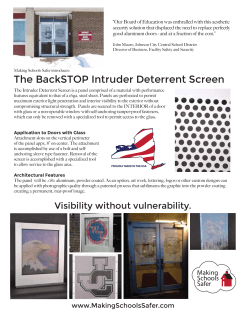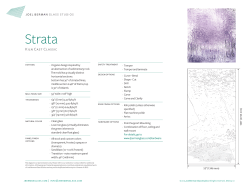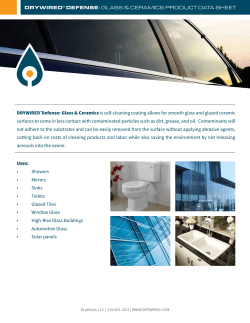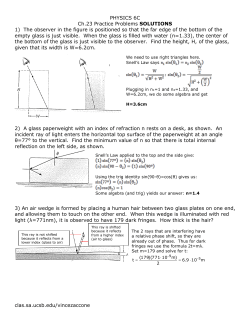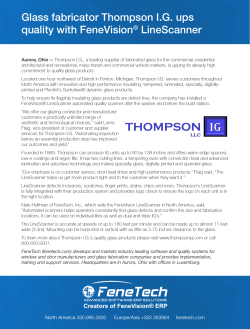
Synthesis of Bioactive Glass and its Antibacterial Effect on
Received: Apr 21, 2015 Accepted: May 05, 2015 Published: May 08, 2015 Aperito Journal of Infectious Disease and Vaccines Research http://dx.doi.org/10.14437/AJIDV-1-108 Mahmoud M Elhaig, Aperito J Infect Dis Vaccines 2015, 1:2 Synthesis of Bioactive Glass and its Antibacterial Effect on Mupirocin Resistant, Methicillin-Resistant Staphylococcus Aureus Samaa A Taha1, Mahmoud M Elhaig2* and Azza Nady MH3 1 Department of Microbiology and Medical Immunology, Faculty of Medicine, Suez Canal University, Ismailia, Egypt 2 Department of Animal Medicine (Infectious Diseases), Faculty of Veterinary Medicine, Suez Canal University, Ismailia, Egypt 3 Department of Basic Sciences, Higher Technological Institute, 10th of Ramadan City, Egypt Abstract Keywords: Antibacterial Effect; MRSA; Mupirocin Rapid resistance to mupirocin occurs among Resistance; Sr-doped glass; FTIR& XRD of bioactive glass strains of Methicillin-Resistant Staphylococcus Aureus (MRSA) which the main etiological agent is causing community-acquired and hospital-acquired infections. Introduction Powdered samples of Sr-doped glass, of composition 70 Resistance in human pathogens is a big challenge in SiO2- (30–x) CaO- xSrO were prepared by sol – gel pharmaceutical fields and biomedicine. Antibiotic resistance method. XRD and FTIR confirmed the calcined glass profiles lead to fear about the emergence and reemergence of existed in the amorphous state. Sr doped glass exhibited Multi Drug-Resistant (MDR) pathogens and parasites [1]. antibacterial effect onmupirocin resistant MRSA strains Infection with MDR bacteria cannot be cured easily and by the agar-disk diffusion method. The inhibition zone requires a multiple treatment of broad-spectrum antibiotics, increased as the concentration of Sr ions was increased. Sr which are less effective, more toxic and more expensive [2]. release was dependent on bioactive glass composition Therefore, development of or modification in antimicrobial with increasing Sr substitution resulting in higher compounds to improve bactericidal potential is a priority area of concentrations in the medium. Sr for Ca substitution in the research in this modern era [3]. glass is a promising bactericidal bioactive material till 3% Methicillin-Resistant Staphylococcus Aureus (MRSA) SrO, but SrO substitution above that ratio doesn’t further strains are a major causal agent of community-acquired and improve bactericidal effect hospital-acquired infections [4]. Mupirocin (Bactroban; SmithKline Beecham Pharmaceuticals), is one of the most * Corresponding Elhaig, effective topical antibiotics used for eradication of nasal Department of Animal Medicine (Infectious Diseases), carriage of MRSA [5, 6]. With increased use of mupirocin, Faculty of Veterinary Medicine, Suez Canal University, staphylococcal strains with high and low levels of resistance Ismailia, have been reported [7]. Most commonly, low-level (MICs = 8 to Egypt; Author: Tel: Mahmoud +20 mahmoudvet1975@gmail.com M 643327052; E-mail: 256 µg/ml) mupirocin-resistant strains are isolated, while high Copyright: © 2015 AJIDV. This is an open-access article distributed under the terms of the Creative Commons Attribution License, Version 3.0, which permits unrestricted use, distribution, and reproduction in any medium, provided the original author and source are credited. Volume 1 • Issue 2 • 108 www.aperito.org Citation: Mahmoud M Elhaig (2015 Synthesis of Bioactive Glass and its Antibacterial Effect on Mupirocin Resistant, MethicillinResistant Staphylococcus Aureus. Aperito J Infect Dis Vaccines 1:108 Page 2 of 7 http://dx.doi.org/10.14437/AJIDV-1-108 level (MIC ≥ 512 µg/ml) mupirocin-resistant strains are then their antibacterial effect on mupirocin resistance MRSA infrequently isolated. High-level mupirocin resistance has been was investigated. connected with clinical and microbiological failure [8, 9]. Nanoparticles have promising applications in diagnostics, biomarkers, cell labeling, antimicrobial agents, Materials and Methods Bacterial Isolates drug delivery systems for handling of various diseases [10, 11]. Thirty nasal swabs were taken by rotating a sterile Hence, researchers are shifting towards nanoparticles to solve cotton swab, moistened with sterile saline, in the vestibule of the problem of the emergence of multi- drug resistant bacteria both anterior nares of medical and paramedical personals [12]. working in Suez-Canal University Hospital during the period A more recent field of research is the synthesis of anti- from May 2012 to October 2013. Trypticase Soy Broth (TSB) bacterial glasses as bioactive glasses are the only one, which was used as a transport medium. The swabs were put directly could bond to hard and soft tissue. Biomaterials in nano-scale onto Mannitol Salt Agar (MSA) (Merck, Germany) and sent to could stimulate the reaction between the materials and cells the laboratory and incubated at 35º C in a humidified incubator [13]. Continuous work is done to improve the properties of for 48 h. Strains that produced yellow colonies on the MSA biomaterial to have antimicrobial properties. Sr–doped glasses plate, were sub cultured on a blood agar plate (Merck, have been shown to exhibit enhanced cellular bioactivity and to Germany), for further characterization. The staphylococcal release critical concentrations of Sr ions in the range of 1–5 ppm isolates were identified by conventional methods, e.g. colonial into dissolution medium [14]. Moreover, ion release from Sr– morphology, gram staining characteristics, production of doped silicate glasses enhances the bone cell activity and catalase, coagulase tube method using rabbit plasma, DNase in inhibited osteoclasts differentiation when directly applied in tube tests and other biochemical tests [21]. contact with cells as solid bioactive glass–discs. Bioactive glass forms a firm bond with living tissues via the establishment of a hydroxyapatite layer on their surface [15, 16]. MRSA Isolation Isolates showing inhibition zones of ≤10 mm and ≤21 Sol–gel technique, as a chemical method, provides an mm around 1 mg oxacillin (Oxoid, Cambridge, UK) and 30 µg available means to synthesize bioactive glass with higher purity cefoxitin (Oxoid, Cambridge, UK) disks respectively, were and homogeneity at low temperatures [17]. In recent years, phenol typically characterized as MRSA. strontium has been incorporated into dental and orthopaedic biomaterials to reduce microbial contamination by inhibiting Mupirocinsusceptibility Testing bacterial growth and reproduction and impeding permeability of The MICs for S. aureus isolates to mupirocin were the cytoplasmic membrane, cell wall synthesis, replication of assessed using E-test® mupirocin strips (AB-BIODISK, Solna, bacterial chromosomes and cell metabolism [18, 19]. Strontium Sweden) according to the manufacturer’s instructions. The E- for calcium substitution in the glass adjusted the bactericidal test strip was applied onto each plate of Mueller-Hinton agar properties of the bone cements making strontium a promising that was inoculated with a suspension of isolates to the optical bactericidal component of bioactive glasses and related density of a 0.5 McFarland standard with sterile forceps. biomaterials [20]. Following incubation at 35° C for 24 h. E-test MIC values were In the present study different compositions (x = 0, 1, 3 read by the operator at the point where the bottom of the and 5%) of SrO substituted bioactive glasses in the (70 SiO 2 – inhibition zone intersected with the E-test strip. Strains were 30 - x CaO – x SrO) system were synthesized and characterized considered to be susceptible if the MIC value was ≤ 4 mg/L and Volume 1 • Issue 2 • 108 www.aperito.org Citation: Mahmoud M Elhaig (2015 Synthesis of Bioactive Glass and its Antibacterial Effect on Mupirocin Resistant, MethicillinResistant Staphylococcus Aureus. Aperito J Infect Dis Vaccines 1:108 Page 3 of 7 http://dx.doi.org/10.14437/AJIDV-1-108 levels of mupirocin resistance were defined as low-level with Table 1: Glass composition (weight %) and Sr for Ca MIC 8–256 mg/l and high-level with MIC ≥ 512 mg/L [22]. substitutions Detection of the mupA Gene by PCR Glass SiO 2 CaO Sample a Sr 0 70 30 - the DNA, a loop full of bacterial cells from each sample was Sample b Sr 1 70 29 1 removed and resuspended in 250 µl of sterile distilled water and Sample c Sr 3 70 27 3 Sample d Sr 5 70 25 5 All the strains were analyzed by Polymerase Chain SrO Reaction (PCR) for the presence of the mupA gene. To extract 0 the suspension incubated in a 90 C heat block for 15 min. Centrifugation followed (7500 x g, 5 min) and the supernatant containing the staphylococcal DNA extract was transferred into new test tubes and frozen for later PCR amplification. Five micro liters of the extracted DNA was transferred to 20 µl of the Characterization PCR amplification mix consisting of; 2.5 µl of 10 X buffer, 1.5 For characterization, the phase analysis of the samples was mM of MgCl 2 , 1.5 U of Taqpolymerase, 1.25 µl of dNTPs and examined by X–ray diffractometer, model BRUKER axes, using 1.5 µl of each primer. To detect the mupA gene, a 456-bp Ni–filtered CUKa irradiation at 40 KV and 25mA.The infrared region was amplified by PCR, using a primer pair Mup1 (5’- spectra of the prepared glass were obtained using Fourier TAT ATT ATG CGA TGG AAG GTT GG-3’) and Mup2 (5’- Transform Infrared spectrophotometer (FT–IR) (Model 580, AAT AAA ATC AGC TGG AAA GTG TTG-3’) [23]. Cycling Perkin–Elmer). Each sample was pressed in pellet and mixed parameters were 940C for 5 min followed by 30 cycles, with KBr substrate. FTIR spectrum was recorded in the 4000– denaturation at 94 0C for 30 s, annealing at 52 0C for 30 s and 400 Cm–1 region. extension at 720C for 30 s, and final 5 min incubation at 720C. Following PCR amplification, the amplified PCR products were Antibacterial Activity Test The antibacterial activity of Sr–doped glasses was analyzed by agarose gel electrophoresis stained with ethidium bromide and the amplicons were visualized using a UV light evaluated box. using the agar-disk diffusion method. Freshly prepared bacterial Synthesis of Bioactive Glass inoculums were swabbed on sterile petri-dishes 90mm in CaO was replaced by SrO on a molar base as shown in diameter against mupirocin containing sterile resistant MRSA Mueller-Hinton strains agaras table 1, the system was produced by Sol – gel method using recommended by CLSI [24]. The medium was swabbed three TetraEthylOrthoSilicates (TEOS), calcium nitrate tetra hydrate times by rotating the plate 600 after each application to ensure Ca (NO 3 ) 2 . 4H 2 O, and strontium nitrate Sr (NO 3 ) 2 [17]. the spread of the bacteria over the entire surface of the plates. Briefly, TEOS, distilled water and 2M nitric acid were mixed in The discs of the prepared Sr–doped glasses were placed using ethanol and the mixture was allowed to react for 60 min under sterile forceps on the seeded agar surface and incubated at 370c continuous magnetic stirring for the acid hydrolysis of TEOS. for 24hrs.The antibacterial activity was deduced from the Then Ca (NO 3 ) 2 .4H 2 O was added and stirred for 30 min, the Inhibition Zone Diameter (IZD), zone of no bacterial growth, SrO was added and stirred for the same period. The mixture was measured left at room temperature to form gel. Each prepared gel was The antibacterial activity increases with the increase in IZD and dried at 75oC for 2 days in a drying oven and finally gels were vice versa. under the stated experimental conditions. stabilized by heat treatment up to 700oC. Volume 1 • Issue 2 • 108 www.aperito.org Citation: Mahmoud M Elhaig (2015 Synthesis of Bioactive Glass and its Antibacterial Effect on Mupirocin Resistant, MethicillinResistant Staphylococcus Aureus. Aperito J Infect Dis Vaccines 1:108 Page 4 of 7 http://dx.doi.org/10.14437/AJIDV-1-108 at 870 – 1040 cm-1 is related to the Non-Bridging Oxygen (Si– Results In this study Sol-gel method showed a fast method for O–NBO). preparing bioactive glasses. The XRD pattern of bioactive glass powders of Sr 0 , Sr 1 , Sr 3 and Sr 5 for 0 % SrO, 1% SrO, 3% SrO and 5% SrO, respectively after heating to 700 0C is presented in Figure 1. The XRD study confirmed the glass existed in an amorphous state, generally no diffraction peaks could be observed. Figure 2: FTIR spectra of synthesized gel glass with different amounts of SrO (Sr 0 , Sr 1 , Sr 3 , and Sr 5 ). Out of the 30 MRSA strains tested, low-level mupirocin resistance was detected in only 2 (6.6%) MRSA strains using E test as their MICs were 12 and 16 µg / ml. PCR analysis of the mupA gene confirmed its presence in these 2 strains while the rest of the strains tested were susceptible to mupirocin (Figure 3). Figure 1: XRD patterns of gel glass after heating to 700 0C for Sr 0 , Sr 1 , Sr 3 , and Sr 5 . Figure 2 showed the FTIR spectra for the bioactive glass powders after heating to 700 0C. For glass samples, the band located in the range 1000-1200 cm-1 corresponds to the Si–O–Si asymmetric stretching vibration, and the band located at 440 – 540 cm-1 corresponds to the vibrational mode of the binding of Si–O–Si. The bands located at 670-740 cm-1 correspond to Si–O symmetric stretch of Bridging Oxygen Figure 3: PCR analysis of the mupA gene using 1% agarose gel (BO) between tetrahedron chains, and the shoulder of spectrum electrophoresis, M represent the DNA - size maker (100 bp Volume 1 • Issue 2 • 108 www.aperito.org Citation: Mahmoud M Elhaig (2015 Synthesis of Bioactive Glass and its Antibacterial Effect on Mupirocin Resistant, MethicillinResistant Staphylococcus Aureus. Aperito J Infect Dis Vaccines 1:108 Page 5 of 7 http://dx.doi.org/10.14437/AJIDV-1-108 ladder); lanes 1 and 3 represent positive samples; lane 2 represents a negative sample for the mupA gene. Figure 4 shows the antibacterial effect of the preparation Sr–doped glasses on the diagnosed mupirocin resistant MRSA strains using the agar-disk diffusion method. It was found that, Sr–doped glasses were highly effective on the tested organisms, especially sample c containing 0.619 gm of Sr–doped glasses. It showed the highest clearing inhibition zone, which was nearly 33 mm in diameter, while other samples (sample b & d) showed only 28- 30 mm inhibition zones. The sample without Sr–doped glasses (sample a) had no effect on the tested bacterial isolates. Figure 5: The relationship between SrO concentration and inhibition zone diameter in mm Discussion The broadening of absorption band Si – O – Si as shown in Figure 2, indicates the amorphous nature due to disorder in silicate network [17] for all samples, which was confirmed by XRD. When strontium is added to silica, the band at 823 cm-1 for NBO will shift to higher wave number depends on the amount of strontium. At the same time, the shift from 950 cm-1 to a lower wave number due to the lower charge – to – size ratio of Sr2+ (owing to slightly larger ionic radius) was shown to cause an expansion of the silicate network, making it less strongly ionically cross linked [20] causing breakdown of silicon network and formation of short and terminal chains. Different frequencies of mupirocin resistance among S. aureus isolates has been clearly defined in many parts of the world, for example,Spain11.3%, USA 13.2%, Trinidad Tobago 26.1%, China 6.6%, India 6%, Turkey 45% and Korea 5%, however, it does appear to be increasing worldwide [25]. The limited Figure 4: The antibacterial effect of the prepared Sr–doped number found in this study could be attributed to the limited use glasses on a representative mupirocin resistant MRSA strain. of that antibiotic to eliminate MRSA nasal colonization as a part of the infection control measures in our hospitals. Also, it is The inhibition zone increased as the concentration of infrequently used for the treatment of skin infections. Sr ions was increased as Sr release was dependent on the The inhibition zone increased as the concentration of bioactive glass composition with increasing Sr substitution Sr ions was increased as Sr release was dependent on the resulting in higher concentrations in the medium till 3% SrO bioactive glass composition with increasing Sr substitution (Figure 5). resulting in higher concentrations in the medium till 3% SrO. Volume 1 • Issue 2 • 108 www.aperito.org Citation: Mahmoud M Elhaig (2015 Synthesis of Bioactive Glass and its Antibacterial Effect on Mupirocin Resistant, MethicillinResistant Staphylococcus Aureus. Aperito J Infect Dis Vaccines 1:108 Page 6 of 7 http://dx.doi.org/10.14437/AJIDV-1-108 But above 3% SrO the inhibition zone doesn't increase with less 7. Vasquez JE, Walker ES,FranzusBW, Overbay BK, bactericidal action which could result from decreased Sr release ReaganD R, SarubbiFA,(2000). The epidemiology of with strontium substitution above that level [20]. mupirocin Rapid resistance to mupirocin occurs among strains of among methicillin-resistant Staphylococcus aureus at a Veterans’ Affairs Hospital. S. aureus isolated from hospitals. Therefore, monitoring for mupirocin resistance in S. aureus, especially in MRSA, is resistance Infect. Control HospEpidemiol 21:459–464. 8. Saderi H, Owlia P, Habibi M, (2008).Mupirocin necessary to evaluate the usefulness of mupirocin in both the resistance among Iranian isolates of Staphylococcus treatment of staphylococcal infections and infection control. Sr aureus. Med SciMonit 14 (10):BR210-3. for Ca substitution in the glass was shown to be a promising 9. Lim KT, Hanifah YA, MohdYusof MY, Thong bactericidal bioactive material till 3% SrO. But the amount of Sr KL,(2010). Prevalence of mupirocin resistance in above this ratio doesn’t improve bactericidal action. methicillin-resistant Staphylococcus aureus strains isolated from a Malaysian hospital. Jpn J Infect Dis 63 References 1. 2. Tenover F, (2006). Mechanisms of antimicrobial nanopharmaceutical Webb GF, D’Agata EM, Magal P.Ruan S, (2005). A NanosciNanotechnol 8: 2216–2229. 5. 6. delivery systems. J 11. Singh R, Singh NH, (2011). Medical applications of hospitals. Proc Nat AcadSci 102: 13343–13348. nanoparticles in biological imaging, cell labeling, Humberto H, Lara V, Ayala-Nunez NV, Carmen LD, antimicrobial agents, and anticancer nanodrugs. J Ixtepan T, Cristina RP, (2010). Bactericidal effect of Biomed Nanotechnol 7: 489–503. silver nanoparticles against multidrug-resistant bacteria. 4. 10. Marcato PD, Duran N, (2008). New aspects of resistance in bacteria. Am J Med 119: S3–S10. model of 499 antibiotic-resistant bacterial epidemics in 3. (4):286-9. 12. GemmellCG, Edwards DI,Frainse AP, (2006). World J MicrobiolBiotechnol 26: 615–621. Guidelines for the prophylaxis and treatment of Askarian M, Zeinalzadeh A, Japoni A, Alborzi A, methicillin-resistant Staphylococcus aureus (MRSA) Memish ZA, (2009). Prevalence of nasal carriage of infections in the UK. J AntimicrobChemother 57: 589– methicillin-resistant Staphylococcus aureus and its 608. antibiotic susceptibility pattern in healthcare workers at 13. Webster TJ, Ergun C, Doremus RH, Bizios R, (2002). Namazi Hospital, Shiraz, Iran.Int J Infect Dis13 Hydroxylapatite with substituted magnesium, zinc, (5):e241-7. cadmium, and yttrium. II. Mechanisms of osteoblast PerlTM,Cullen JJ, Wenzel RP, Zimmerman MB, Pfaller adhesion. J. Biomed. Mater. Res, 59(2), 312-317. MA, Sheppard D, TwombleyJ,French PP, Herwaldt 14. Hoppe A, Güldal NS, Boccaccini AR, (2011). A review LA,(2002). Intranasal mupirocin to prevent postoperative of the biological response to ionic dissolution products Staphylococcus aureus infections. N. Engl. J. Med. from 346:1871–1877. ceramics. Biomaterials, 32(11), 2757-2774. bioactive glasses and glass- Kalmeijer MD, Coertjens H, van Nieuwland-BollenPM, 15. Gentleman E, Fredholm YC, Jell G, Lotfibakhshaieh N, Bogaers- Hofman D, de BaereGA, Stuurman A, van O'Donnel MD, Hill RG, Stevens MM, (2010). The Belkum A, Kluytmans JI,(2002). Surgical site infections effects of strontium – substituted bioactive glasses on in orthopedic surgery: the effect of mupirocin nasal osteoplasts and osteoclasts in vitro, Biomaterials 31 (14): ointment in a double-blind, randomized, placebo- 3949 – 56. controlled study. Clin Infect Dis 35:353–358. Volume 1 • Issue 2 • 108 www.aperito.org Citation: Mahmoud M Elhaig (2015 Synthesis of Bioactive Glass and its Antibacterial Effect on Mupirocin Resistant, MethicillinResistant Staphylococcus Aureus. Aperito J Infect Dis Vaccines 1:108 Page 7 of 7 http://dx.doi.org/10.14437/AJIDV-1-108 16. Jebahi S, Oudadesse H, El Feki H, Rebai T, Keskes H, Pellen P, El Feki A, (2012). Antioxidative/oxidative effects of strontium-doped bioactive glass as bone graft. glasses. J. of The Royal Society Interface, rsif20120647. 21. Halablab MA, Hijazi SM, Fawzi MA, Araj In vivo assays in ovariectomised rats. Journal of Applied GF,(2010).Staphylococcus aureus nasal carriage rate and Biomedicine, 10(4), 195-209. associated risk factors in individuals in the community. 17. El-Gohary MI, Tohamy KM, El-Okr MM, Ali AF, Epidemiol Infect 138 (5):702-6. Soliman IE, (2013). Influence of composition on the in- 22. Saderi H, Owlia P, Habibi M. (2008).Mupirocin vitro bioactivity of bioglass prepared by a quick alkali- resistance among Iranian isolates of Staphylococcus mediated sol–gel method. Nat. Sci, 11(3): 26 – 33. aureus. Med Sci Moni14 (10):BR210-3. 18. Alkhraisat MH, Rueda C, Cabrejos-Azama J, 23. Yun HJ, Lee SW, Yoon GM, Kim SY, Choi S, Lee YS, LucasAparicio J, Marin˜o FT, Torres Garcia-Denche J, Choi EC, Kim S, (2003).Prevalence and mechanisms of Jerez LB, Gbureck U, Cabarcos EL,(2010). Loading and low- release of doxycycline hyclate from strontiumsubstituted staphylococci isolated from a Korean hospital. J calcium phosphate cement. ActaBiomater. 6: 1522 – AntimicrobChemother51 (3):619-23. 1528. and high-level mupirocin resistance in 24. Clinical and Laboratory Standards Institute (2009). 19. Dabsie F, Gregoire G, Sixou M, Sharrock P, (2009). Performance standards for antimicrobial susceptibility Does strontium play a role in the cariostatic activity of testing; nineteenth informational supplement M100-S19. glass ionomer?: Strontium diffusion and antibacterial Clinical and Laboratory Standards Institute, Wayne, PA. activity. J dentistry, 37(7), 554-559. 20. Brauer DS, Karpukhina N, Kedia G, Bhat A, Law RV, 25. Mohajeri P, Gholamine B, Rezaei M, Khamisabadi Y,(2012). Frequency of Mupirocin Resistant Radecka I, Hill RG, (2012). Bactericidal strontium- Staphylococcus aureus Strains Isolated From Nasal releasing injectable bone cements based on bioactive Carriers in Hospital Patients in Kermanshah. Jundishapur J Microbiol.5(4):560-63. Volume 1 • Issue 2 • 108 www.aperito.org
© Copyright 2025


